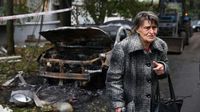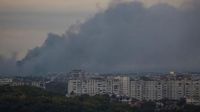In the early hours of October 5, 2025, Ukraine awoke to one of the most intense and devastating aerial assaults since Russia’s full-scale invasion began in February 2022. According to reports from multiple sources, including ABC News, The Associated Press, and Al Jazeera, Russia unleashed a barrage of nearly 550 munitions—comprised of drones, missiles, and guided aerial bombs—across the country in a coordinated overnight attack. The strikes stretched from the western city of Lviv, close to the Polish border, to the embattled Zaporizhzhia region in the south, and as far east as Kharkiv, Sumy, and Kherson.
Ukrainian President Volodymyr Zelenskyy described the onslaught as another instance of "aerial terror," emphasizing the scale and brutality of the attack. "Today the Russians again struck our infrastructure, everything that ensures a normal life for people," Zelenskyy said in a post on Telegram, as reported by ABC News. He reiterated his call for Western allies to expedite the delivery of air defense systems, warning, "More protection is needed, faster implementation of all defense agreements, especially regarding air defense, to make this aerial terror meaningless."
The scope of the assault was staggering. Ukraine’s air force reported that Russia launched 496 drones and 53 missiles of various types, with defenders managing to down or suppress 439 drones and 39 missiles. Eight other missiles failed to reach their targets, but eight missiles and 57 drones still impacted across 20 locations, leaving debris scattered in at least six regions. The attacks were concentrated in western Ukraine, a region that, until recently, many Ukrainians considered a relative haven from the war’s front lines.
Lviv, a historic city known for its cultural heritage and once viewed as a sanctuary from the violence farther east, bore the brunt of the attack. Regional officials, including Lviv Mayor Andriy Sadovyi and Maksym Kozytskyi, head of the local military administration, confirmed that four people—including a 15-year-old girl—were killed in the village of Lapaivka. Several others were injured. Sadovyi described "a very tough night," noting that an industrial park west of the city center and a business complex on the outskirts were among the buildings hit. The strike was the largest aerial assault on Lviv and its surrounding region since the start of the invasion, according to The Associated Press.
The attacks left two districts of Lviv without power and disrupted public transportation for several hours. The regional prosecutor’s office reported that the strikes also targeted gas infrastructure—an especially cruel blow as a cold snap gripped the region. The damage to energy facilities was so severe that, according to Serhii Koretskyi, CEO of Ukraine’s state-owned Naftogaz Group, Sunday’s attack inflicted further large-scale harm on gas infrastructure that supplies civilians. "Russia’s goal was to deprive Ukrainians of gas, heat, and electricity," Koretskyi stated in a Naftogaz release.
Elsewhere, the southern frontline city of Zaporizhzhia was pummeled by drones and guided aerial bombs, killing one civilian woman and injuring at least nine others, including a 16-year-old girl. Regional Governor Ivan Fedorov said the assault destroyed residential buildings and damaged gas pipelines, leaving more than 73,000 households without power. Service was restored to most residents by early afternoon, but the psychological and material toll lingered. "Russian munitions damaged gas pipelines, residential homes and other buildings," Fedorov wrote on Telegram.
Chernihiv, close to the Belarusian and Russian borders northeast of Kyiv, also reported strikes on critical infrastructure. In the eastern city of Sloviansk, a guided aerial bomb slammed into an apartment block, injuring six people—including a child—and damaging over two dozen residential buildings, cars, shops, and a café, according to regional prosecutors cited by The Associated Press.
Russia’s Defense Ministry characterized the operation as "a massive strike with long-range precision-guided weapons of ground, sea and air-based deployment," claiming that the attacks targeted "enterprises of Ukraine’s military-industrial complex and the gas and energy infrastructure facilities that supported their operations." Among the weapons systems employed were Kinzhal hypersonic ballistic missiles and strike drones. "The strike objectives have been achieved," the ministry asserted on Telegram, insisting that "all designated targets have been struck."
The overnight barrage triggered a swift response from NATO. Poland’s Operational Command stated that fighters were deployed and air defense units placed on alert as Russian missiles and drones approached the Polish border. Dutch F-35 jets were among those scrambled, but no violations of Polish airspace were observed. The alert lasted around four hours, underscoring the potential for spillover into neighboring NATO territories.
On the diplomatic front, tensions escalated as Russian President Vladimir Putin warned that the supply of long-range U.S. weapons—specifically Tomahawk cruise missiles—to Ukraine would mark a "qualitatively new stage of escalation" and could "lead to the destruction of our relations, or at least the positive trends that have emerged in these relations," as he said in a video released by Russian state television. The warning followed reports that U.S. President Donald Trump, in a recent phone call with German Chancellor Friedrich Merz, was informed about European plans to use frozen Russian assets to support the Ukrainian armed forces.
Meanwhile, Ukraine has not remained passive. Ukrainian forces have conducted their own long-range strikes on Russian territory, particularly targeting oil infrastructure in the Belgorod region. These strikes have caused power outages for some 40,000 people and injured several, according to Belgorod’s regional governor and Russian state media. Russia’s Defense Ministry claimed to have shot down 62 Ukrainian drones overnight and through Sunday morning, while TASS reported the interception of four Ukrainian guided aerial bombs and 145 drones in a 24-hour period.
As winter approaches, the pattern of Russian attacks on Ukraine’s power grid has intensified. Kyiv officials accuse Moscow of attempting to weaponize the weather by depriving civilians of heat, light, and running water—a tactic employed in previous winters. Zelenskyy, in his nightly address to the nation, charged that Moscow is "openly trying to destroy our civilian infrastructure now, before winter—our gas infrastructure, electricity generation and transmission." He lamented the lack of a "dignified, powerful global response" to the increasing scale and brazenness of the strikes, warning that Russian President Vladimir Putin is "simply laughing at the West’s silence and lack of a strong response."
In the aftermath of the assault, the need for enhanced air defenses and international solidarity has never been clearer. As the conflict drags on and temperatures drop, the resilience of Ukraine’s people—and the resolve of its allies—will be tested again and again.






